With ‘Pranayama’ breathing exercise in yoga, you can increase your intake of oxygen up to five times. The more oxygen rich blood to brain, heart, lungs and digestive organs will enable these organs work better and further bolster your health. It is hard to imagine how we can live in such an unclean environment. Air pollution can affect us — kids, adults, and even plants and animals. What is worse is our future children will get used to inhaling toxic air as if it is a normal thing. If we value our health, we also have to take care of the air we breathe so we can live a longer and healthier life. The respiratory system includes the lungs, nose, mouth, and other connected parts. These body parts allow oxygen to flow in the body. When we inhale, oxygen converts into energy. In return, humans exhale it out of the body as carbon dioxide. Carbon dioxide is toxic to humans but is important for animals and plants. Oxygen is important for humans. It ensures proper body function and normal breathing which keeps us alive.
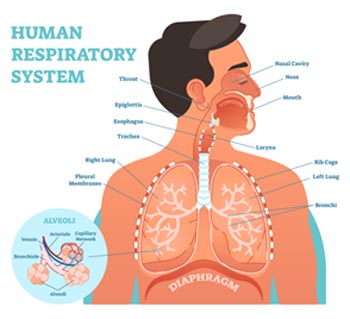
Yoga Benefits on The Respiratory System
Healthy respiratory system ensures proper circulation of oxygen in our body. It promotes better health and proper body function. Our entire body is dependent to the air we breathe. We could die within just a few seconds without air. There is no better time to take care of your respiratory health. One way to improve respiratory health is by practicing proper breathing. In the world of Yoga, this breathing exercise is also known as Pranayama.
Many studies reveal that Pranayama increases oxygen intake by up to five times. A rich supply of oxygen can remove toxins from our bodies. In return, it can improve your health in the long run.
- Practicing proper breathing can also reduce anxiety and stress. It also improves blood flow, body posture, and reduces inflammation.
- With selected yoga poses, proper breathing can bring positive effects on respiratory health. You will feel invigorated after doing these breathing exercises.
- Pranayama improves your breathing. But, there are a lot of yoga benefits on the respiratory system. As mentioned, proper breathing can improve oxygen intake. Aside from that, it can also help in the proper function of your heart, lungs, and brain.
- It can also reverse the effects of aging and other similar health problems. It also aids in stretching and strengthening the chest muscles and the spine. Learning the art of proper breathing can provide the best benefits to your health.
Yoga Asanas For Repiratory Health
Doing yoga exercises can help improve your health. It does not matter whether you have respiratory problems or not. Knowing the correct breathing technique can be beneficial to your well-being. Combining breathing exercises with popular yoga poses can improve your respiratory health. Common yoga poses that can improve your respiratory health include the following:
Cobra Pose (Bhujangasana)
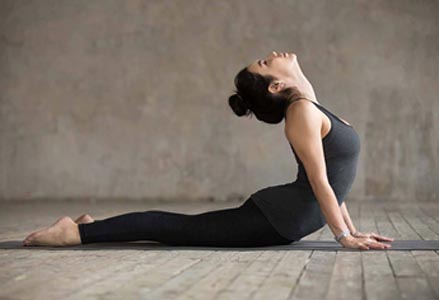
This yoga pose helps expand the lungs and heart for better oxygen circulation. This also serves as a good stretching exercise for your back.
- Start by lying on your stomach and rest your forehead on the floor.
- Keep your feet together and your toes touching the ground. Place your hands at shoulder level and palms on floor
- As you inhale lift your head, chest and abdomen and make sure that you keep the navel on the floor.
- Hold this posture for 5 breaths
- As you exhale, slowly come down rest with your hands below your head.
Cat Stretch (Marjariasana)
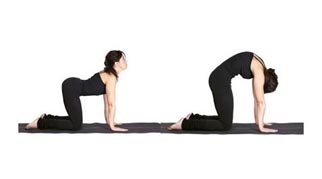 This yoga pose requires deep breathing. It aids in blood circulation and lung expansion to make you feel better.
This yoga pose requires deep breathing. It aids in blood circulation and lung expansion to make you feel better.
Formation of the posture:
- First of all, kneel on the ground.
- There should be a gap between the knees and the feet.
- Now bend forwards and keep both hands flat on the floor in front of the knees.
- Makes ensure that the hands should be directly below the shoulders.
- The thighs should also be vertical.
- Exhale, pull your back upwards and head should face the thighs.
- Inhale, make your head raise up and the back should take concave shape.
- This is one cycle. Do 2-3 rounds as per your convenience.
Chakrasana or the Wheel Pose
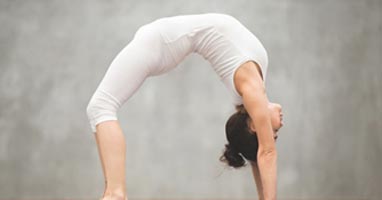
The chest expands and the lungs get more oxygen – this makes the pose especially beneficial for respiratory health & especially for asthma patients.
Formation of the posture:
- Fold your legs at your knees and ensure that your feet are placed firmly on the floor
- Place your palms next to your ears, with fingers pointing forward
- Inhale, put pressure on your palms and legs and lift your entire body up to form an arch
- Allow your head to fall gently behind and keep your neck relaxed
- Keep your body weight evenly distributed between your four limbs
- Breathing Methodology: Inhale while lifting the body up
Setubandhasana
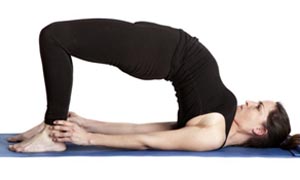
Improve lungs capacity, stimulates respiration, good for asthma.
Formation of the posture:
- Lye on the mat with your back on the floor.
- Draw your feet inwards towards the hips.
- Your feet should be parallel to each other.
- Knees should not be pointing outwards.
- Now lift yourself up with your stomach going towards the ceiling along with your back, hip and thighs.
- Chin and chest should be locked.
- You can either keep your hands sideways or engage them in supporting your back. You can also clasp them under your back and stretch. Inhale while going up, hold, exhale while coming down. Breathe normally in case you are holding the pose for long.
SARVANGASANA
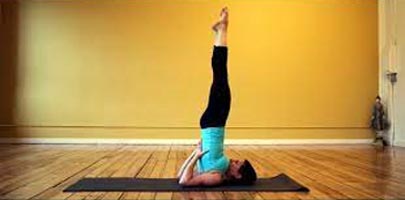
Regular practice of Sarvangasana relieves respiratory disorders such as asthma, shortness of breath and heavy breathing. Do not perform this asana when you get an asthmatic attack. To get into the pose, lay flat on your back with arms by your side with palms facing downwards
Formation of the posture:
- Lie down on your back straight.
- Breathe in and breathe out, lift your both legs in the upward direction.
- Stop at that point when both legs make a 90-degree angle with the floor.
- Make the Uttanpadasana Posture.
- While exhaling lift your waist; push your legs back over the head.
- Use your both hands for supporting waist.
- Get your legs, back, and waist in one straight line.
- Stretch your toes towards the sky, keep your eye on your toes.
- Hold the position for some time, keep normal breathing.
- Slowly get back to initial position.
- Repeat this for three to four times.
BHASTRIKA PRANAYAMA
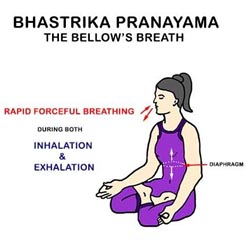
Great for lungs and people who suffer from repetitive cough, flu, respiratory issues, allergies or breathlessness. It is good for brain oxygenation.
How to Perform Bhastrika
- Sit in Padmasana (Lotus Pose).
- Take a deep breath and fill your lungs with air.
- Release the breath after counting till five.
- Now begin practicing the technique by inhaling and exhaling with force and mimicking the panting activity.
ANULOMVILOM PRANAYAMA
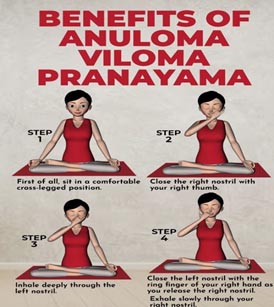
- cleanses and strengthens the entire respiratory system;
- expels more stale air and waste products from your lungs, because exhalation is twice the time of inhalation;
- decreases respiratory rate, prolongs exhalation, and thus leads to increased carbon dioxide levels in the blood, which in turn leads to improved oxygen absorption in the cells;
- Anulom Vilom Pranayama is very easy to do, first of all, close your eyes and sit in Padmasana and rest your hands on your knees.
- Close the right nostril with the right thumb. Inhale slowly through the left nostril, inhale the oxygen as much as you can, this will fill your lungs with air.
- Remove your thumb from your right nostril, as you remove your thumb from right nostril just exhale.
- When you exhale use your middle finger to close your left nostril then inhale with our right nostril and remove the thumb from the right nostril then exhale. Repeat this process for 5 minutes.
- Be focused and concentrate on your breathing.
 |
Dr. Sujata Panda, PhD in Yoga, DNYS, N.D., Gold medallist, Founder of Su-Ham Foundation Owner of Viroga Virtual Clinic |


